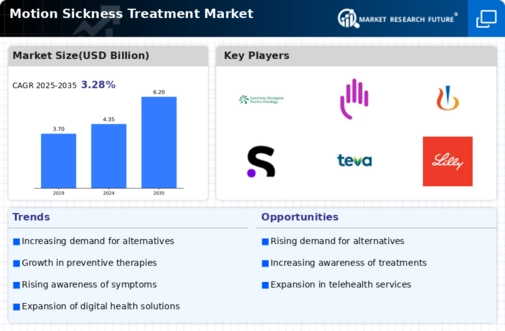Growth of Travel and Tourism
The growth of the travel and tourism sector is a crucial driver for the Motion Sickness Treatment Market. As more individuals engage in travel activities, the incidence of motion sickness is likely to rise, prompting a greater demand for effective treatments. The tourism industry has been experiencing a resurgence, with millions of people traveling by air, sea, and land, often leading to discomfort associated with motion sickness. This trend suggests that the market for motion sickness treatments could see a significant uptick, as travelers seek remedies to enhance their experiences. The Motion Sickness Treatment Market is thus positioned to benefit from this expanding consumer base.
Emergence of Alternative Therapies
The emergence of alternative therapies for motion sickness is contributing to the diversification of the Motion Sickness Treatment Market. Consumers are increasingly seeking holistic and natural remedies, such as acupuncture, herbal supplements, and aromatherapy, as alternatives to traditional medications. This shift reflects a broader trend towards wellness and self-care, with many individuals preferring non-pharmaceutical options. Market Research Future indicates that the demand for natural remedies is growing, with a notable increase in sales of herbal supplements specifically targeting motion sickness. This trend not only broadens the treatment landscape but also highlights the evolving preferences of consumers within the Motion Sickness Treatment Market.
Increasing Awareness of Motion Sickness
The rising awareness regarding motion sickness and its impact on daily life appears to be a significant driver for the Motion Sickness Treatment Market. Educational campaigns and health initiatives have contributed to a better understanding of the condition, leading to increased demand for effective treatments. As more individuals recognize the symptoms and seek solutions, the market is likely to expand. Reports indicate that approximately 30 percent of the population experiences some form of motion sickness, which underscores the potential market size. This heightened awareness is fostering a proactive approach to treatment, encouraging consumers to explore various options available in the Motion Sickness Treatment Market.
Advancements in Pharmaceutical Solutions
Recent advancements in pharmaceutical solutions for motion sickness are likely to propel the Motion Sickness Treatment Market forward. Innovative formulations and delivery methods, such as transdermal patches and fast-acting oral medications, are emerging to meet consumer needs. The market has seen a notable increase in the introduction of prescription medications that offer enhanced efficacy and reduced side effects. For instance, the global market for antiemetic drugs, which includes motion sickness treatments, was valued at over 4 billion USD in 2023, indicating robust growth potential. These advancements not only improve patient compliance but also expand the range of options available in the Motion Sickness Treatment Market.
Technological Innovations in Treatment Delivery
Technological innovations in treatment delivery systems are poised to enhance the Motion Sickness Treatment Market. The integration of wearable technology and mobile applications for monitoring and managing symptoms is becoming increasingly prevalent. These innovations allow for real-time tracking of motion sickness triggers and personalized treatment plans, which could improve patient outcomes. Furthermore, the development of smart devices that administer medication at optimal times may revolutionize how motion sickness is treated. As technology continues to evolve, it is likely to play a pivotal role in shaping the future of the Motion Sickness Treatment Market, offering consumers more effective and tailored solutions.
























Leave a Comment